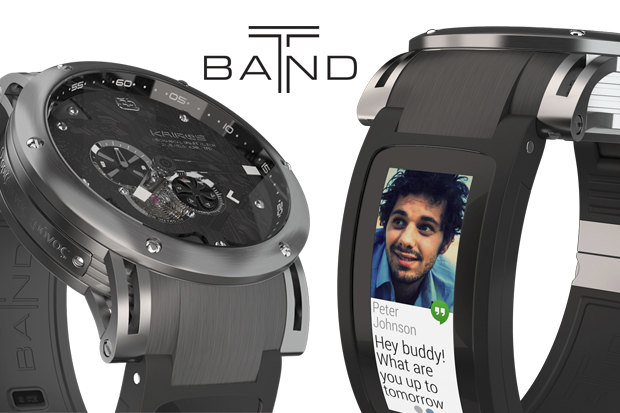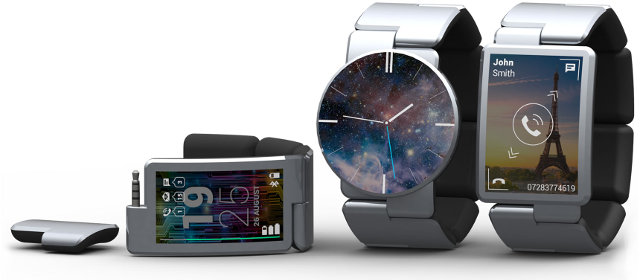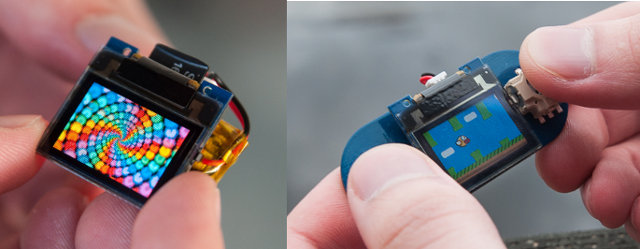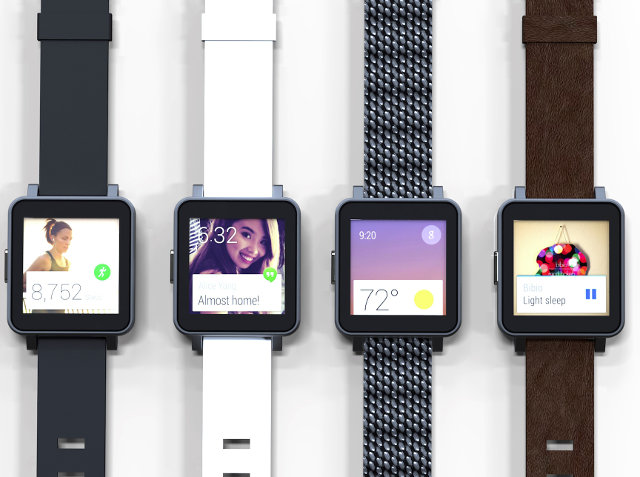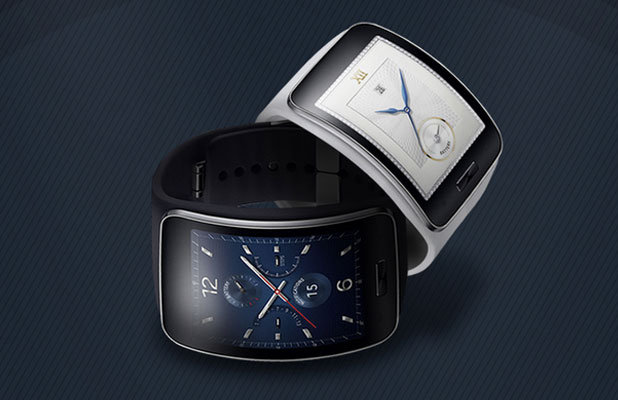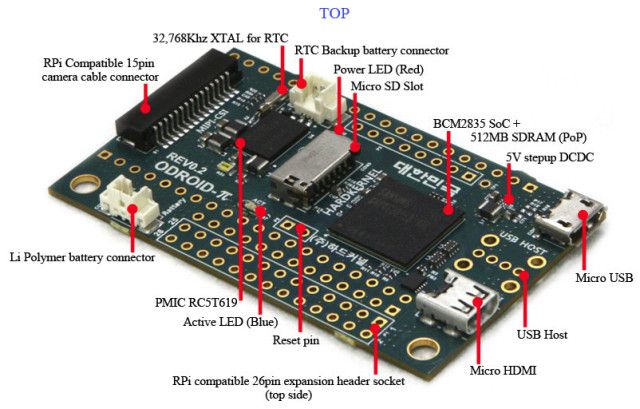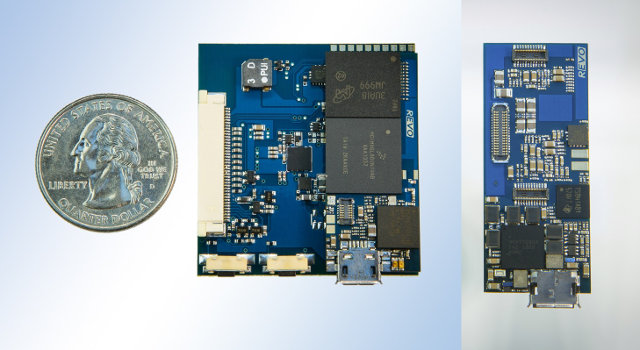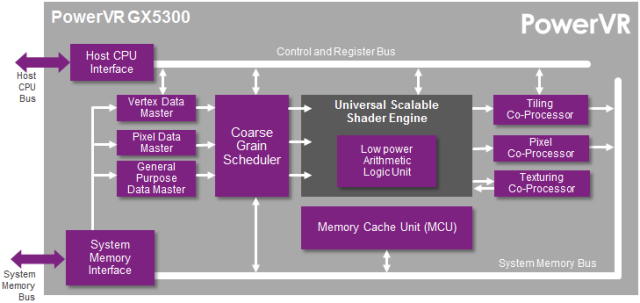Kairos introduced a high-end mechanical smartwatch with a semi-transparent OLED display a few months ago. They’ve now launched an Indiegogo campaign to sell several models for $500 to $1,000+, but they’ve also introduced T-Band, a smart watchband with an integrated display that you can fit to your existing (mechanical) watch, in order to receive notifications, answer phone calls, get directions, and even start your car. There are three models of smartband all running Kairos OS on an ARM Cortex M4 MCU @ 168 MHz with Bluetooth Classic / Low Energy: T-Band ND (No Display) Alerts user of notifications via a vibrator and LED indicator, and tracks fitness / sleep, as well as health data. Sensors – 9-axis gyroscope, accelerometer, compass, optical sensor, and GSR (Galvanic Skin Sensor) which detects skin temperature and sweat. Audio – Digital MEMS MIC for text to speech capabilities (requires 3rd party app) Battery – 200 mAh […]
Meet Blocks, a Tizen Modular Smartwatch based on Edison Board
If you like Phoneblocks / Project Ara module model concept, you may also be interested in Blocks, a modular smartwatch comprised of blocks connected via 3.5mm jacks. The watch is running Tizen on Edison development board powered by Intel dual-core Atom + Quark SoC, and part of the 10 finalists of Intel’s Make It Wearable challenge. Most smartwatches comes with a dumb” watchband, but with Blocks both the actual watch, and watchband are smart and customizable. You can change from round to square display, and add modules, which are part of the watchband, adding features like GPS, heat rate monitor, motion sensors, extra battery capacity, SIM card, contactless payment, temperature sensors, and so on. Each module also have a removable cover to let you change the color. One of the main drawbacks of current smartwatches is the battery life (1 to 2 days), so if it is possible to connect […]
$25 TinyScreen is an OLED Display for TinyDuino Arduino Compatible Board (Crowdfunding)
Back in 2012, Tiny Circuits launched a Kickstarter campaign for TinyDuino, an Arduino compatible board that’s… tiny, based on Atmel Atmega328P, and supports tiny stackable shields in a similar fashion to Microduino (launched in 2013). The campaign was successful, and the company is now back on Kickstarter with TinyScreen, an OLED display that can be stacked on top of TinyDuino to create a smartwatch, a minuscule gamepad, smart glasses, and more. TinyScreen technical specifications: 96×64 OLED display, 16-bit color depth 0.96″ (24.4mm) viewable area Software controllable backlight (OLED brightness) Power down mode Four push buttons along the sides (connected to IO pins) SPI interface for display Power Supply – 3.0V to 5.5V operation (higher voltages supported with TinyShield power regulator) Power Consumption – 20 – 45mA max supply current (depending on brightness) Dimensions – 25.8mm x 25.0mm Programming of TinyDuino can be done through a web interface for Arduino called […]
$125 Com 1 Android Wear Watch Powered by Ingenic JZ4775 MIPS Processor (Crowdfunding)
If you’d like to get an Android Wear watch, but are not quite ready to spend $200+ for the models currently available, the Com 1 Android Wear smartwatch could be interesting as you may get one for as low as $125, albeit with higher risks since it’s part of a flexible funding Indiegogo campaign. The watch is powered by Ingenic JZ4775 MIPS processor, features a 1.6″ AMOLED display, and is IP67 rated (Water- and dust-proof). Com 1 watch hardware specifications: SoC – Ingenic JZ4775 XBurst (MIPS) processor @ 1.0 GHz with 2D graphics, and VPU (MPEG-2, MPEG-4, VC-1, H.264, VP8, RV9), 720p@30fps System Memory – 375 MB LPDDR1 Storage – 4 GB eMMC Display – 1.6” AMOLED touchscreen display, 320 x 320 resolution, 16.7 Million Colors , LED back light, Brightness: 300 cd/m^2. Connectivity – WiFi (802.11 a/b/g/n at 2.4/5 GHz), Bluetooth 4.0 + EDR (BLE Compliant), FM, and NFC Sensors – […]
Samsung Gear S SmartWatch and Tizen SDK for Wearables
Albeit Tizen struggle in the smartphone market widely reported by the tech press, devices from cameras to smartwatches, all made by Samsung, are currently selling with the new mobile operating system. Announced about two weeks ago, Samsung Gear S is the latest Tizen product launched by the company. The smartwatch features a 2″ curved display (Samsung likes curved displays), Bluetooth, Wi-Fi, etc.. and it can also make phone calls and access the internet over 2G/3G cellular networks. Samsung Gear S specifications: SoC – Dual core processor @ 1.0 GHz (Maybe Exynos 3250 like in Gear 2?) System Memory – 512MB Storage – 4GB internal storage Display – 2.0” Super AMOLED touchscreen display with 360×480 resolution Connectivity – WiFi 802.11 b/g/n, Bluetooth 4.1, A-GPS/Glonass Cellular Network 900/2100 or 850/1900 (3G) 900/1800 or 850/1900 (2G) USB – micro USB 2.0 Audio Codecs – MP3/AAC/AAC+/eAAC+ Audio Formats – MP3, M4A, WMA, AAC, OGG […]
Hardkernel Unveils $30 Raspberry Pi Compatible Module with RTC, ADC, and LiPo Battery Support
Hardkernel is better know for its ODROID boards powered by Samsung Exynos SoC. So I was surprised to discover ODROID-W, “a miniature computing module which is fully compatible with all software available for the Raspberry-Pi”. Software compatible, really? Yes, because they used the same Broadcom BCM2835 SoC found in the Raspberry Pi, packaged it in a smaller form factor, while keeping HDMI, USB, and CSI interface, and expansion headers, and all that for $30, plus just $9 for shipping. Let’s go through ODROID-W specifications first: SoC – Broadcom BCM2835 ARM1176JZ-F processor @ 700 Mhz with VideoCore IV GPU System Memory – 512MB LPDDR2 (Samsung K4P4G324EB PoP) Storage – microSD slot + eMMC socket (bottom of the board) Video Output – micro HDMI (with NXP IP4791CZ12 protection IC) USB – micro USB connector, and USB host (not soldered) Expansion Headers: R-Pi compatible 26-pin expansion header (through holes) R-Pi compatible 15-pin CSI […]
Freescale WaRPBoard Reference Platform for Wearables is Now Available for Pre-order
Back in January, Freescale announced WaRP (Wearable Reference Platform) comprised of the WaRPboard, a tiny board based on Freescale i.MX 6SoloLite running Android, and a daughter board with KL16 Cortex M0+ MCU and several sensors. The company collaborated with Revolution Robotics for the hardware design, and Kynetics for the software, and the platform is now available for pre-order for $149, and a few more details have surfaced since my first article. The hardware specifications of WaRP are as follows: WaRPboard: SoC – Freescale i.MX 6SoloLite Cortex A9 processor @ 1GHz with 2D graphics Vivante GC355 and GC320 GPUs. System Memory – LPDDR2 (Micron Multi-Chip Package) Storage – 4Gbit eMMC (Same Micron MCP chip as for RAM) Connectivity – WLAN and Bluetooth 4.0 LE via Murata LBEH17YSHC Display I/F: MIPI DSI for LCD display + touchscreen EPCD for E-Ink Display Sensors – Xtrinsic FXOS8700CQ, 6-Axis Sensor with Integrated Linear Accelerometer and Magnetometer. Daughtercard: […]
Imagination Technologies Unveils Low Power Low Footprint PowerVR GX5300 GPU for Wearables
Up to now most wearables are based on MCU solutions or derived from mobile platforms, which may either not provide the advanced features required by users, or consume too much power and take more space than needed. With Ineda Dhanush and Mediatek Aster, we’ve already seen silicon vendors design wearables SoCs, and now Imagination Technologies has just announced PowerVR GX5300 GPU targeting wearables with support for OpenGL ES 2.0, 480p to 720p resolution, and using 0.55mm2 silicon area based on 28nm process. PowerVR GX5300 GPU will be support Android, Android Wear, and Linux based operation systems, and according to the company has the following key features: Unified shaders – The TBDR graphics architecture offers unified shaders where vertex, pixel and GPU compute resources are scaled simultaneously. Low power and high precision graphics – All PowerVR GPUs offer a mix of low (FP16) and high precision (FP32) rendering and implement the […]


